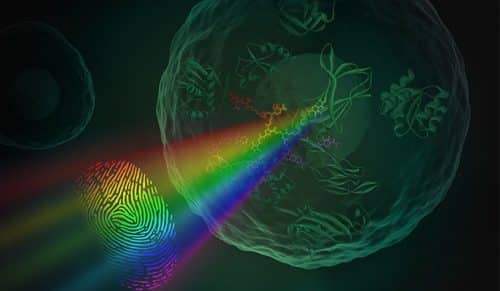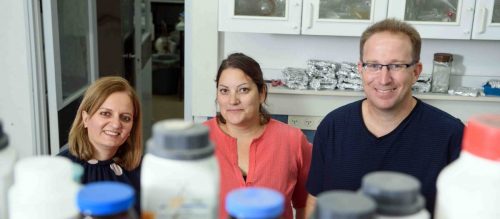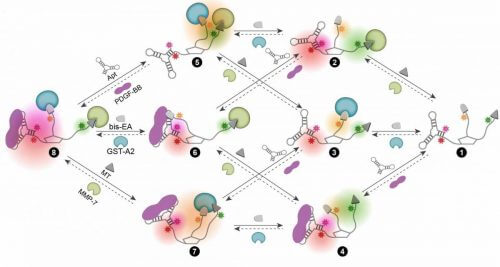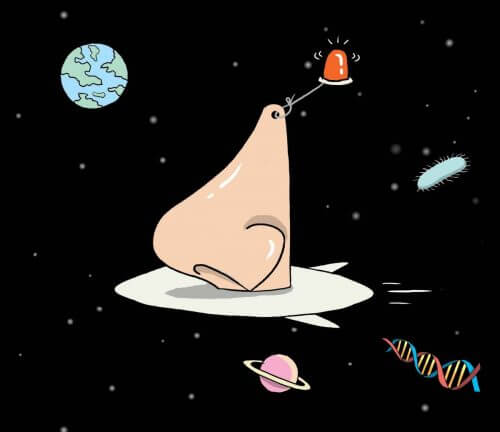Tiny molecular detectors are increasingly being used to detect molecules in microscopic places that are otherwise inaccessible - such as in a single cell. But the most familiar detector to all of us is undoubtedly the nose.

Home kits for pregnancy testing or cholesterol and sugar monitoring are available to anyone who needs them on pharmacy shelves. These preparations are chemical detectors that can detect biological molecules - the presence of the "pregnancy hormone" in the urine or the measurement of cholesterol and glucose values in the blood. In the research field, tiny molecular detectors are increasingly being used to identify molecules in microscopic places that are otherwise inaccessible - such as in a single cell. But the most familiar detector to all of us is undoubtedly the nose. Unlike a pregnancy test or a tiny detector inserted into a cell, the nose is a multi-purpose detector that can distinguish between thousands of different molecules and mixtures of molecules that differ in the different smells they produce.
"The different smells are created by combinatorial sensing," explains Prof. David (Didi) Margolis from the Department of Organic Chemistry at the Weizmann Institute of Science. "While most chemical detectors consist of a specific receptor for one molecule and a 'transmitter' capable of translating the binding into an optical or electrical signal, the nose consists of an array of non-specific receptors and 'transmitters' capable of binding to different molecules at the same time. This is how the different molecules in the smell are distinguished according to the signature of the received signals, that is, by a unique code for each molecule sent from the nerve cells to the brain."
In recent decades, researchers have drawn inspiration from the olfactory organ and developed "artificial noses" - electronic or chemical sensor arrays designed to be used, among other things, to prevent the leakage of dangerous substances or to detect explosives and drugs. "Electronic noses", for example, are built from an array of electronic sensors coated with different materials - so that each sensor better absorbs some molecular group. As soon as the molecules in the air are adsorbed to the sensors, the electric current changes and a signature is obtained which represents a certain molecular composition. "Similarly," adds Prof. Margolis, "there are also 'optical noses' capable of identifying mixtures in a solution by creating a unique color signature." Since it is a solution, some would prefer to call these detectors "artificial tongue". However, unlike the nose, the language's ability to detect is limited to a much smaller number of materials.

Despite the great progress in the creation of combinatorial detectors, these "noses" cannot "sniff" what is happening in the cell or other microscopic territories - due to their dimensions. Recently, the laboratory of Prof. Margolis succeeded in combining the compactness of the molecular nanodetectors with the versatility of the artificial noses. In a new study published in the scientific journal Nature Nanotechnology, the researchers describe how for the first time they inserted a miniaturized artificial "nose" into a living cell. The tiny "nose" consisting of a single molecule, may be used in the future for a variety of medical and industrial applications. Says Prof. Margolis: "Just as the most sophisticated telescope is not sufficient to study chemical compositions in distant stars, so the most advanced microscope is also not sufficient to characterize compositions in the microscopic world such as a single cell. Therefore, similar to sending detectors into space, there is also a need to send molecular noses into the nanospace"
The first "nose" in nanospace
In order to produce a miniaturized "nose" capable of distinguishing between different mixtures of molecules in a solution, the researchers produced a molecule that combines different molecular receptors with fluorescent groups capable of shining in different colors. This combination allows the nose molecule to bind a large amount of different substances and emit a unique light signature in response to any substance or mixture it encounters. Besides the ability to detect a large amount of materials, the miniaturized detector is versatile and can monitor dynamic processes by changing the light signatures it emits.
In the current study, the "nose" was composed of three "receptors" for three protein families known to be of great importance in biological processes as well as in disease states: the matrix metalloprotease (MMPs) and glutathione S-transferase (GSTs) enzyme families and the platelet-derived growth hormone (PDGFs) family. In addition, the detector included four fluorescent "emitters" capable of producing unique light signatures for the various protein molecules and their combinations. "There are so many proteins in the cell. If you take a combinatorial detection system that is completely non-specific, it would be like trying to smell a molecule in a garbage can", explains Dr. Leila Mutai, the need for selectivity for three protein families.
Just as the most sophisticated telescope is not sufficient to study chemical compositions in distant stars, so the most advanced microscope is not sufficient to characterize the compositions in the microscopic world such as a single cell. Therefore, similar to sending detectors into space, there is also a need to send molecular noses into the nanospace."

The researchers subjected the sensor they created to a variety of tests such as identifying different mixtures of proteins in different biological solutions, including in body fluids such as urine. After that, we turned to the highlight: launching the "nose" into a living cell. "We caused cells in culture to express certain proteins, inserted the sensor into them and showed that identity signatures are obtained from different cells," adds research student Zohar Fuda. "Then we created environmental effects - such as inflammation or lack of oxygen - and showed that the 'nose' produces a unique signature that reflects the state of the cell."
The molecular nose may be used in the future to test quantities and levels of a variety of substances in living cells, and report the findings to researchers and doctors; In this way it will be possible to locate disease markers and identify diseases in the initial stages. Besides medical diagnosis, the research also demonstrates possible uses of this type of sensors in more effective drug development: "One way to develop drugs is to take a protein that is too active in a certain disease, and look for an inhibitor for it by testing hundreds of thousands of chemicals. The 'nose' we developed makes it possible to simultaneously test interactions between inhibitors and different enzymes, thus shortening processes," says Prof. Margolis. However, the 'nose' is not limited only to applications in the field of health, but opens up the possibility of chemical sensing of the entire nanometer space.
Also participating in the study were Dr. Roni Perry-Naur, Joseph Gargson, Dr. Tal Ilani from the Department of Structural Biology, Vladimir Kish from the Department of Biomolecular Sciences, Dr. Tamar Unger from the Center for Structural Proteomics, and Dr. Barak Marcus and Dr. Haim Bar From the Israeli National Center for Personalized Medicine named after Nancy and Steven Grand.

More of the topic in Hayadan:

One response
Let's also not forget the "Electronic nose of Dr. Hussam Hayek from the Technion also smells kidney diseases" article here on the Hidaan website.
Yehuda